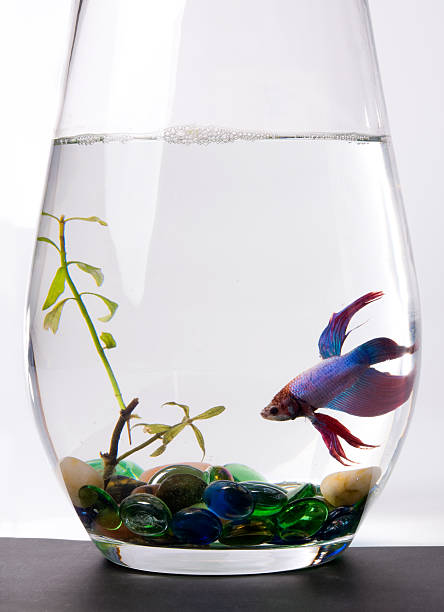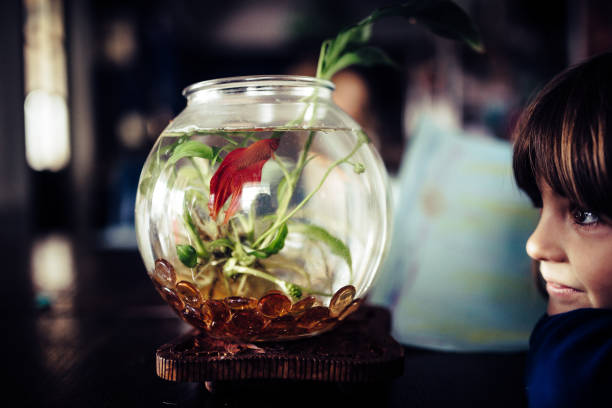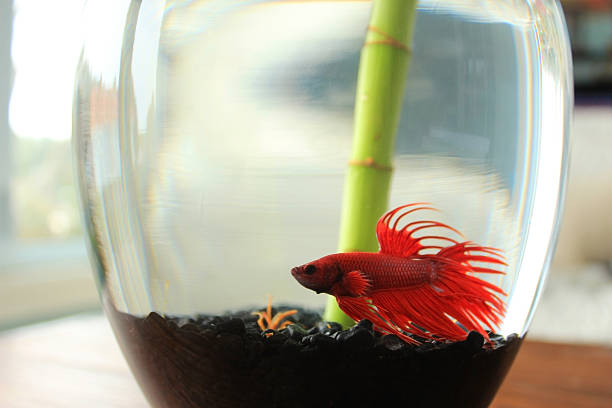Can a Betta Fish Live in a Vase With a Plant: Steps & Care Tips
A lot of people have bettas as pets. They are a type of fish that is very popular because they are easy to care for and they come in a variety of colors. Some people choose to keep their bettas in a fish tank, while others choose to keep them in a vase with a plant.
Yes, a betta fish can live in a vase with a plant. A betta fish can live happily in a vase with a plant. Just be sure to add some rocks or gravel for stability and to provide spots for the fish to hide. Like other tropical fish, the bettas need oxygen and water to survive so placing them in an environment with plants will provide these needs. Make sure the plant is not too large or dense and that there are enough spaces for the fish to swim around. There should be plants that the fish can climb on and swim around so they will feel safe.

Table of Contents
How to Put Betta Fish in a Vase With Plant
Step 1: Choose the Type of Vase
There are a few different types of vases that can be used to house a betta fish. Some people opt to use glass or plastic vases because they are easy to clean. Other people choose to use ceramic or metal vases because they are more decorative and offer a more secure environment for the fish. It is important to choose a vase that is big enough for the fish to swim in but not so big that it becomes difficult to care for the fish.
Step 2: Choose a Vase that is the Right Size for Your Bettas
There are many different sizes of vases that can be used with bettas. Some bettas may prefer a larger vase, while others may prefer a smaller vase. It is important to choose a vase that is the right size for your betta fish. If the vase is too small, your betta may not have enough room to swim and could become stressed. If you are in doubt about what type of vase will work better with a betta then just look at different types that have been made by other people and see which one works best for yours. Or look at an aquarium store near you that has lots of different-sized hardware containers available so you can test them out for your betta.
Step 3: Choose the Aquatic Plant for the Vase
Many plants can be used in a vase with a betta fish. Some common plants that can be used are water lilies, floating plants, and ferns. These plants provide a lot of oxygen and nutrients for the fish, as well as a place to hide. Other plant species that you can take into consideration are waterweeds, Cryptocoryne, Vallisneria, Cattleya orchids, and Anubias.
Step 4: Clean the Vase with a Clean Towel
If your betta fish is living in a vase with a plant, you may want to clean the vase with a clean towel to keep the plant and betta fish healthy. It is always a good idea to clean your vase and plant regularly to keep your fish happy and healthy. To clean the vase, use a clean towel to wipe down the sides and top. In addition, make sure you clean the vase at least once a week.
Step 5: Add Water and Plant to the Vase
Adding water and a plant to a vase with a betta fish can help to keep the fish healthy and happy. Provided that the water is clean and the plant is low-maintenance, a betta fish in a vase can be a fun and easy addition to any home. The water depth should correspond with the size of your vase. Additionally, if you have a betta that prefers to swim around in tight spaces be sure to choose a vase whose height corresponds with the length of its body. Betta fish need a lot of hiding places, so the tank should have plenty of these. The vase should also be large enough that the fish can swim around without bumping into things. Make sure to choose a vase that is at least 10 inches deep and has room for rocks and plants.
Step 6: Place Your Bettas in the Vase
There is no right or wrong answer when it comes to placing your betta fish in a vase with a plant. Some people believe that betta fish prefer to live in close quarters with other fish, while others believe that bettas can survive in a vase with a plant if the plant is small and the water is kept clean. Ultimately, it is up to the owner of the betta fish to decide what is best for their pet.

How to Take Care of Betta in a Vase With Plant
Space
When you first get a betta fish, it is important to provide him or her with plenty of space in the vase. Betta fish are territorial and will become stressed if they don’t have enough room to swim around freely. You can buy a vase tank if you want, but it’s best to start small and gradually work your way up as your fish grows more accustomed to its new home.
Compatible Plant
Plants shelter your betta, and they also provide him or her with food. Adding the compatible plants to your vase will help to improve the oxygen levels in the water, which is important for fish health. Additionally, plant life can absorb ammonia and other toxins from the water, making it easier for your pet fish to live a long and healthy life in its habitat. Be sure to choose plants that are low-water vegetation or aquatic plants, because plants that require a lot of water or carnivorous plants can quickly turn your vase into an underwater saloon.
Healthy Diet
Your betta fish is an omnivore, and as such, he or she needs a diet that includes both meat and plant material. A varied diet will help to ensure your pet fish’s optimal health. Some good sources of protein for your betta include live bloodworms, small crickets, earthworms, and even special betta food pellets made specifically for omnivorous fish. In addition to protein, your tank should also have algae flakes, fresh vegetables and fruits, and some dry kibble to provide your fish with the essential vitamins and minerals it needs.
Water Changes
The betta fish should have access to fresh water at all times. To make this happen, change the water in the vase regularly. Checking and changing the water is one of the best ways to keep your vase tank healthy and thriving. Add enough fresh water so that it reaches halfway up the vase’s sides, but do not overfill it because doing so can cause your fish to drown. This is important because if you do not regularly change the water, your betta will quickly and steadily become too weak to survive in its environment or even attempt breeding in new tanks where potential offspring could die before they can reproduce as well. It’s very important to keep a clean and constantly maintained vase, so you can enjoy time with your beloved pet fish.
Water Temperature
The specific temperature of the water is also very important. Vases must be kept at a stable room temperature, so if you keep them in your bedroom by putting them under an open window or on top of other furniture that’s not insulated properly and warm enough to keep the vase safe from extreme fluctuations, move your aquarium into another part of the house where temperatures are more consistent. Betta fish should be able to handle temperature ranges of 75 to 80 degrees Fahrenheit (23 to 26 degrees Celsius).
Heater
If you live in an area where the water temperature is usually below 75 to 80 degrees Fahrenheit, consider equipping your aquarium with one. Most betta fish thrive best at this temperature and when oxygenated for about 3 inches or so around their body that includes tails, fins, and gills outside of their air-compatible bubble. A wall-mounted heavy-gauge pump operated by ventilated tubing system delivers refreshing water from one tank to the other.
Filtration
Betta fish thrive on hard, high-quality water that is not too soft and temperature controlled. The most common type of fish is commercially produced in gallon containers or betta vases you add to your home aquarium setup. As mentioned before, a filter attached to the vase’s interior sides will keep the water properly oxygenated. Choose long-lasting filters with some kind of mechanical action (cylinders made according to several manufacturers’ instructions and filters with activated carbon).
Hiding Spots
Adding hiding spots and decoration will give your betta fish some places to hide. Adding hiding spots will give your betta fish some places to hide. For the safety of your new vase tank, you should always make sure that it is clear and open for a visual check during water changes, so that if anything were accidentally knocked over or otherwise escaped the bowl at any point in time throughout use, you could locate where it once was on the bottom of the water. In addition, hiding spots are also very important for a betta fish’s safety and social comfort during the winter months when dark means no natural light can reach inside your planted vase to brighten it up.

How to Keep Betta Fish From Jumping Out of Vase?
Betta fish are tropical fish that can thrive in a variety of environments, but they may still jump from a vase with a plant. A betta’s natural habitat is in and around water, so if you want to keep your betta fish in a vase, you’ll need to provide a suitable environment for him. Some tips to help keep your betta fish from jumping out of the vase include providing plenty of hiding spots and providing a water dish for him. You should also make sure the vase is big enough for the fish to swim around in. Another is to put a plant large enough in the vase that the fish can nibble on. Finally, make sure the water in the vase is clean and fresh.
How to Move Your Bettas to Larger Tanks?
At around six to eight weeks old your betta will be ready for a larger aquarium. This could be as small as an 18″ or 20″ long tank but should have at least 65 gallons of water and space reserved exclusively for your betta fish. Remember, when moving them, always keep the fish in fresh water until it has settled into its new home.